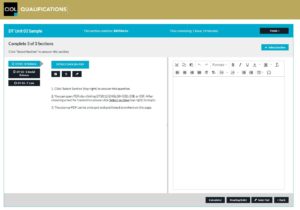The CIOL DipTrans exam online platform came into being for the 2021 exams in response to social distancing. This article will tell you everything you need to know about the online option for sitting the exam remotely.
The lowdown on the remotely delivered DipTrans exam
The Chartered Institute of Linguists now has an online examination platform. This means that, from 2021 onwards, translators worldwide can sit the CIOL Diploma in Translation exam online, from the comfort of their own homes. Professional translators welcomed this move from the Chartered Institute of Linguists and our candidates reported positively on the exam experience.
This article is from the keyboard of Helen Gräwert, who was among the candidates who pioneered the platform. Helen prepared for the DipTrans exam by doing The Translator’s Studio DipTrans preparation course.
Before the exam
In the lead up to the exam, the CIOL provided a Candidate Guide to Remotely Delivered Exams, which detailed the rules for candidates, and two FAQ documents with answers to candidates’ questions. We were also given access to three test units on the exam delivery platform.
A week before the exam, the CIOL emailed candidates their unique links for logging into each unit. Candidates had to do this half an hour before their first paper, and 10 minutes before any following paper, to give them time to go through the necessary ID verification steps.
What were the advantages and disadvantages of the remote DipTrans exam online platform?
On the whole, the CIOL’s move to offer the DipTrans online had many more pros than cons.
For one, in view of COVID restrictions, it protected the time and money candidates had already invested (the DipTrans exam fee is non-refundable). Other upsides were extra time and financial savings because candidates avoided travel and hotel costs for attending an exam centre in person.
And, of course, it meant no space or weight limits on the number of reference books and printed materials translators could have to hand. Many previous candidates who struggled with heavy suitcases getting to an exam centre would have appreciated this.
Despite the understandable concerns among some translators about being the guinea pigs to use this DipTrans exam delivery method for the first time, there were very few downsides (read on for details).
Check out this great article for the pros and cons of the CIOL #DipTrans exam online platform #t9n Share on X
What did candidates need to sit the exam?
To take the exam online, candidates needed a PC or laptop with one monitor screen only, plus a webcam and either a built-in or standalone microphone. These enabled the online invigilator to see and hear candidates during the exam. The platform only works properly with the latest Chrome browser, so it was essential to have this installed too.
The Candidate Guide to Remotely Delivered Exams clearly stated that there could be no second computer monitor or electronic devices (including calculators) in the room. The desk also had to be clear if the invigilator asked to see it. For some candidates, this was a good opportunity to finally reorganise their home office. (Why didn’t we do this sooner?)
Could candidates test the exam delivery platform?
The platform was an e-assessment system created by Rogo. One month before the exam, the CIOL sent out test links so that candidates could try out the system and become familiar with the (limited) tools available.
Candidates who did a test run with the system found it very useful. I would strongly recommend doing a test at least a week before the exam. This is because the platform requires some adjusting to arrange the layout to personal preference. You have to make the adjustments each time you enter the system (that is, for each unit). But it’s fairly quick if you’re prepared.
What tools were available for candidates to use?
The DipTrans exam platform included a limited number of tools and features.
A timer at the top of the screen: this counts down to the end of the exam and starts as soon as you enter the exam unit. The timer turns red when 10 minutes are remaining—just for that extra element of panic.
A PDF viewer for showing the paper selected: this includes a thumbnail viewer, a magnifier tool, a rectangle zoom and some image tools. The most useful tools are a standard zoom tool (at the bottom of the PDF screen) and a search field at the top. There is no highlighter tool for selecting sentences or sections of text.
A Word-style toolbar: at the top of the field where you type your translation. It has all the basic word-processing features that you would expect to find except for the option to change the font size and the ability to tab.
If you find the text too small, you can go to “Formats” > “Headings” and select a new size. However, this reverts to “Normal” when you start a new paragraph. Alternatively, you can zoom in to increase the font size of everything in the window using the browser shortcut “Ctrl” + “+” (and “Crtl” + “-” to zoom out again).
The width of the text field can be adjusted by positioning the mouse over the vertical grey bar to the left and then pulling it left or right.
At the bottom of the screen, there is a calculator and a notepad tool, as well as a reading ruler. The ruler also works on the PDF viewer. This is helpful for marking where you are in the source text in the absence of a highlighter tool.
A chat tool for communicating with the invigilator: this is unavailable in the test units. However, when you log in to the platform via an individual link for the actual exam, this chat tool appears at the bottom of the screen.
Don't miss this article if you want the lowdown on the CIOL #DipTrans exam online platform. Share on X
Is it possible to do a DipTrans test paper under exam conditions on the remote platform?
Yes, we strongly recommend that candidates carry out some test translations under exam conditions using the system. Although the sample test papers provided are in English, it is possible to practise using papers in the source language.
To do this, simply open your chosen source text (as a PDF, if possible) and minimise and adjust the window to fill the left-hand side of your monitor screen. Then, minimise and adjust the Chrome browser (with the test unit open in one tab) to fill the other half of the monitor screen. You can then widen the text field to almost the same width.
(Note that the tools in the system, such as the reading ruler, will not work with the PDF viewer used in this case, and the PDF viewer tools may not be the same as the one provided by the exam platform.)
Other quick tips for using the remote DipTrans exam platform
The usual keyboard shortcuts seem to work with the online platform. For example, for quickly highlighting words you want to check, “Ctrl” + “B” will activate “bold”. This might be more efficient than using the “bold” button each time and navigating back to your place on the page. Time can be tight and so every second counts.
If you decide to do a complete mock exam on the platform and want to keep the translation, you must copy and paste it into a different document before the time runs out. If you don’t, you’ll lose it when the mock exam finishes!
Will the spellcheck saga ever end?
Longer running (but less exciting) than Game of Thrones, the spellcheck saga continues despite the new delivery method. According to the Candidate Guide to Remotely Delivered Exams: “the candidate should switch off spelling auto-correction in Google Chrome to avoid their answer text being underlined in red during the exam when typing in the language other than English.”
Despite the confusing wording, it seems to say that spellcheck is not permitted in any language. However, on the CIOL’s own blog it published “Tips from the DipTrans Chief Moderator on Preparing for the Exam” on 2 October 2020, in which it says: “if you are word-processing, use the spellchecker but don’t rely on it exclusively.”
It is also unclear how its use was monitored by exam invigilators. They can see each candidate’s screen, but as they are most likely overseeing several candidates at once, they may not see each screen in detail. Candidates were not asked to prove that spellcheck was off, and this would only underline in the event of a spelling mistake. This could then be corrected almost instantly and perhaps without an invigilator noticing.
As it is an issue of fairness, we contacted the CIOL for clarification on this point but it has not provided a response to date. Our recommendation is therefore to prepare without a spellchecker.
CIOL DipTrans Exam Preparatory Course for Spanish-to-English Translators
The Translator’s Studio is a leader in Spanish-to-English translator training. Our DipTrans preparatory course comes with the most detailed feedback you’ll find anywhere. But don’t take our word for it:
If you are preparing for the Diploma in Translation exam (Dip Trans), I believe this is the best course out there.






0 Comments